The Legend of Zelda: The Minish Cap (Game Boy Advance) Review
By Adam Riley  17.11.2004
17.11.2004
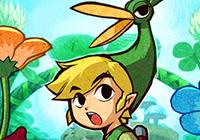
Nintendo and Capcom’s Flagship subsidiary have created three spectacular Zelda efforts so far, Oracle of Seasons & Ages for the GBC and the remake of Zelda: Link to the Past with its multiplayer extra, The Four Sword. The plan was originally that Flagship would produce a fresh Zelda for the GBA early in the system’s lifespan, however the plan was quickly postponed as a Zelda III port was thought to take precedence. But, finally, now The Minish Cap has been completed and we are about to find out if the wait was worth it…
Right from the start things do not look like they are going to head in a good direction. Not at all…Whilst with childhood friend Princess Zelda, the very young Link has to stand back in shock as he watches her get transformed into stone by the evil Vaati, despite his finest efforts to prevent the electrical ball of energy smashing into her by using the new little shield she won at the local fair for him. If that was not bad enough, Vaati breaks the Picori sword, a special talisman that traps all the terrible evil in the world in one small box; therefore everything suddenly pours out, unleashing monsters upon the unsuspecting world. Who can possibly sort it all out, though? The Picori that is who…however they can only be seen by children. Step up Link, the little blonde guy that can wield a sword and grasp his shield firmly – you, the hero! The task is set: fix the legendary sword placed in your possession, soften up the Princess and save the whole world by locking up the evils once more. Not much to ask really, is it?
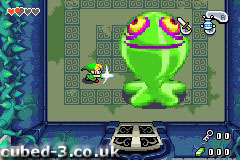
This game is gorgeous – make no mistake about it. Transposing the artistic styling from The Four Sword extra multi-player game found in the Zelda III remake and mixing it together with the cel-shaded look and colourfully fresh feel of The Wind Waker from the GameCube was a brave idea from the Flagship team. Yet it is one that has been pulled off with grace and a certain class. Gone are the dark hues of the SNES outing and in come bright tones, a sparkling palette and wonderful charisma for all of the characters and even the enemies! Enemies have a chunkier, almost 3D look about them, Link scoots around the world without any slowing down at all, the screen transitions are faster than Zelda III on the SNES and there are even characters that prune themselves whilst you watch (the dodgy mayor of Hyrule plucks at his moustache and you can see it bounce back into place when he lets it go!). The amount of detailing that has gone into the work here is immense and it shows that the developer has had the time it wanted to perfect The Minish Cap, giving it a large amount of love and attention so that it could flourish. And flourish it does…
The audio aspect is also a department that Flagship succeeds in. There is a wonderful mixture of tunes lifted from Zelda III on the SNES, such as the overworld theme, as well as music taken from the Nintendo 64 and GameCube outings, take the shop and house ditties for instance, all mixed together with some breath-taking new compositions or complete reworkings of older pieces. Upon entering The Minish Woods or The Minish Village, playing through the Game Boy Player hooked up to a stereo system with great bass will send a shiver down your spine. To be honest, personally I have gone back there and sat listening to the music for a while – it is that good! But it is not just the music that captivates, there is clever use of vocals, with each of the main characters making a little noise before their speech pops up – just like when Navi used to yell ‘Hey’ in the N64’s Ocarina of Time. Magnificent work on the humble handheld and a sign to other developers how things should be done…

Many games just have one facet to them, a single string to their bow. Yet Zelda titles are somewhat different. Take A Link to the Past, for instance, where you were able to travel between the light and dark worlds. Then cast your mind back to the Game Boy Colour duo of Oracle of Time and Oracle of Seasons, both of which involved changing the world around you in order to progress, defeat certain enemies and solve particular puzzles, dungeons and major quests. This is part of the reason Zelda RPGs are so special and beloved by gamers the world over. What you will be extremely thankful for is that that trait has not been overlooked in this latest outing for the Game Boy Advance.
Starting out you have to remember that this is Link at the youngest stage, sans abilities. Therefore you do not have a shield, sword or anything else in your possession. In fact, when the King hands over a small sword to the future hero, you cannot even do the obligatory sword-spin manoeuvre! All you can do is lift your shield and swipe randomly with your sword as you set off on your adventure to gain the help of the Minish folk (what the humans call the Picori). Gradually you will pick up new abilities as your journey progresses, with the already mentioned ‘spin’ being learnt from a friendly Hylian who passes Tiger Scrolls to you depending on your sword status, the Minish Cap itself (which you rescue from some pesky Octoroks, find it is too lazy to walk and end up carrying on your head for the rest of the journey!) and other such things like the traditional bomb bag, as well as a new item – the ‘Gust Jar’.
It is the new aspects that make this so wondrous an adventure, as they fit in perfectly with the staple Zelda-isms. Take the that Gust Jar just mentioned – this handy device could have been lifted straight from the Luigi’s Mansion textbook of gaming, providing a suction device that can pull items toward you (working like the grapple hook of yester-year), suck enemies up and spit them out and, most importantly, help out with the solving of puzzles. You see, this snazzy contraption can suck up dust from the floor (uncovering switches), rip cobwebs from the walls (revealing doorways) and even help you navigate waterways on a leaf (by sucking in air and then blowing a big gust out backwards, thus propelling leaf and hero in the opposite direction). Genius in a jar, seriously.
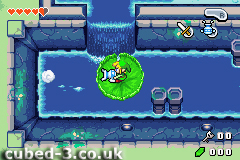
As for the main play itself, you know the drill – wander around finding clues to your next destination by crossing the overworld and quizzing members of the various towns and villages, then head off to the relevant dungeon where you work your way through a myriad of rooms, finding keys, maps, compasses and much more until you reach each dungeons boss. But the inclusion of the Minish Cap twists matters slightly, bringing in that two-way aspect discussed at the beginning of this section – the Minish world is miniscule (hence the rather obvious name) and the special cap allows you to shrink at certain trigger locations. This is where the fun begins as everything that was normal suddenly seems massive as you become ant-like. Puzzles aplenty await using this mechanic and it is by no means a cheap gimmick – it will make your brain hurt, but will entrance you with its magic and keep you glued to your screens for the entire duration of the adventure. Flagship, we bow down to you once more…
As for the main play itself, you know the drill – wander around finding clues to your next destination by crossing the overworld and quizzing members of the various towns and villages, then head off to the relevant dungeon where you work your way through a myriad of rooms, finding keys, maps, compasses and much more until you reach each dungeons boss. But the inclusion of the Minish Cap twists matters slightly, bringing in that two-way aspect discussed at the beginning of this section – the Minish world is miniscule (hence the rather obvious name) and the special cap allows you to shrink at certain trigger locations. This is where the fun begins as everything that was normal suddenly seems massive as you become ant-like. Puzzles aplenty await using this mechanic and it is by no means a cheap gimmick – it will make your brain hurt, but will entrance you with its magic and keep you glued to your screens for the entire duration of the adventure. Flagship, we bow down to you once more…
Zelda games have never been renowned for being lengthy Final Fantasy-esque role playing games, mainly due to the ‘Action’ nature of play and total lack of levelling-up. However, just because you will not be spending in excess of sixty hours playing through a title does not in any way reduce its appeal. From start to 'Minish' (sorry...) this outing delivers what every Zelda adventure has done so far, several dungeons that are just tricky enough to prevent breezing through, yet not so arduous and taxing that your lovely smooth hair will be lying on the floor after one sitting. The lack of requirement to be rid of all enemies in your path is a plus as well, since you will never encounter the frustration of ‘yet another random battle’ and can plough your way onwards until you reach the next puzzle or situation that needs a little bit of thought power. Also, this would not be a true Zelda game if it did not have extras, such as the collect chickens mini-game or the welcome return of the mysterious shells, the kin stones that can be matched with people you meet and stuck together to open new places, and the ‘always a pleasure’ collection of the various heart quarters that will prove vital towards the latter stages. Charge your GBA to the maximum, because you will need every ounce of battery fluid possible for this thirty-plus baby…
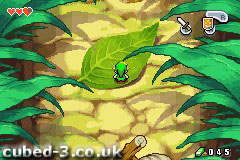
Cubed3 Rating
Exceptional - Gold Award
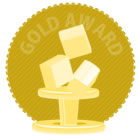
An over-the-top score? I think not – we are talking about the best GBA game on the market so far. We are looking at what can easily be classed as ranking Top 3 out of the whole Zelda series. This is how a game should be made, and if Flagship can produce this amount of quality on such a regular basis, then Nintendo would be foolish not to sign them up for a new DS RPG! Do not even think of hesitating here, you owe it to yourself to buy this…

![]() 9/10
9/10
![]() 9/10
(59 Votes)
9/10
(59 Votes)
 Out now
Out now  Out now
Out now  Out now
Out now  Out now
Out now Comments
Comments are currently disabled

 Sign In
Sign In Game Details
Game Details Subscribe to this topic
Subscribe to this topic Features
Features






 Top
Top

